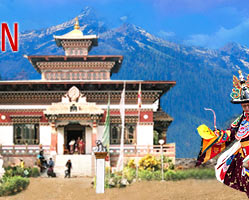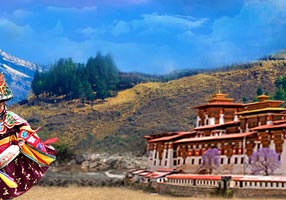14 km from Paro, Drukgyel Dzong was built in 1647 or 1649 at a strategic location to control the routes to Tibet. Shabdrung Ngawang Namgyel built Druk Gyal Dzong, just north of Taktshang, to commemorate the victory over the Tibetans in 1644 and the unification of Bhutan. The name ‘Druk Gyal’ means ‘Fortress of the Victorious Drukpa’. In 1951, the dzong was destroyed by the fire and is closed to all visitors since then. Attempts have been made to renovate the buildings in the dzong since then. Jhomolhari Mountain, the abode and embodiment of the Mountain Goddess Tsheringma who watches over the land, forms the backdrop of Drukgyel dzong. Shabdrung arrive in Bhutan in 1616 but the Tibetan ruler was not content with his biggest enemy leaving Tibet and living in Bhutan and was determined to destroy him. Thus, he attacked Bhutan.
However, Shabdrung was a famous military strategist but the Tibetan troops were beaten off. In 1642, the power of the ruling Tsang in Tibet collapsed and the Gelugpa School, headed by the fifth Dalai Lama, came to power. In 1644, Tibetan and Mongolian armies attacked Bhutan again and were again beaten back. Then, there were other attacks in 1648 and 49 and Tibetans advanced as far as Thimphu, Punakha and Paro but were ultimately defeated. The Bhutanese troops would have killed the enemies but Lama Kuenga Sonam negotiated peace between the Bhutanese and the Tibetans. The prisoners of war were set free to return to Tibet but had to surrender all their arms and ammunitions to the victorious Bhutanese army. Bhutanese constructed Dru Gyal Dzong at Phondoe, where the terms of surrender were signed, to commemorate the victory of the Bhutanese over the Tibetans as well as to prevent possible future attacks. The last Tibetan attack was made in 1957, which was again unsuccessful.
The ruins of the dzong gives us an idea that the height of the dzong would have been about 80 to 90 feet from the base to the top of the utse. Stonewalls are semi-circular and at places where there is a bend in the rock and the rest of the height of the wall, stones around it are cut with finesse. At least eight alternations between semi-circles and vertical angles to the wall can be seen even today. The only entrance to the dzong is known as ‘Gorah Goh’ that led to the second door opening to the first of the three big courtyards. There was a sleeping area for the gatekeeper above the main entrance. The massive pounding stones in the first courtyard indicate that it was used for tethering and feeding the horses of the dzong. A third door opened into the second courtyard, as big as the first one, that had a tower to the right, which served as the residence of the administrator of the dzong, known as the Druezop. On the left of the residential tower were the service areas.
There is a third courtyard with the main tower or ‘Utse’. It is over forty feet high, with four storeys and is an architectural gem. Gyendorm shing, situated besides Utse, is believed to have been the home of a golden pig. There was a Goenkhang in Utse along with a place to stay for monks and religious functionaries. Druk Gyal Dzong’s unique feature is its impregnable double walls that had windows that tapered on the outside and were used to keep an eye on enemies and shoot them, when necessary. The walls surrounding the circumference were partitioned to form an internal passage that allowed people to go to any room without coming out in the open, in the events of attack. The towers were secure within the massive walls. The dzong had two floors.
Ground floor was used as a storage area while the first floor served as the living quarters for the different functionaries of the dzong. One of the finest defense fortresses of Bhutan, Drukgyel Dzong is famous for housing the finest armory in the country and some of the many famous weaponry items include Paak tshen, Paak tshen Lahor, Paak tshen dothung, Jaa da kar gyal, Threy gi paie kar gyal, Boed daa, Chuema jaam sang, Jaa da chuema, Dothung tsawar and Tshadung koepar. The other items that had been collected and stored in Druk Gyal Dzong are ‘loyn thruel’ or tax paid in food grains and ‘kaam thruel’ or tax paid in terms of materials and metals. At one time, Utse used to house the temple of Mahakala and Mahakali and some of its prized possessions were Shacha Thuupa Tenpa and Zhabdrung's Kumba, which is now kept in Rinpung Lhakhang.
Other original nangtens salvaged from the big fire of 1951 in the Dzong included Dorji Datsel, image of Chenrezi, two images of Zhabdrung, 108 volumes of Kanjur, 12 volumes of Bums and Doem Sum Gyoem, a gift from Her Majesty the Queen Mother and some of the weapons. Druk Gyal Dzong also served as the summer residence of Rinpung Rabdey and in the tenth month of Bhutanese calendar, 27th, 28th and 29th days were assigned as the annual days for prayer to Zhabdrung's guardian deities. After the fire of 1951, these prayers are now conducted in Rinpung Dratshang. The expansive and mighty dzong symbolized the power and glory of Bhutan and had shingle-roof. The construction materials for the dzong was selected carefully and imported from all places. Stones for walls and towers did not have to be chiseled and labor worked hard from dawn to dusk under strict supervision.
There are some interesting legends connected to Druk Gyal Dzong. Once the invading Tibetans saw the dzong from the vantage point of Sagala and thought that it was attached to the spur of Jana, a hilltop in that direction but when they reached there the Drukgyel dzong was still further away and everything seemed like a mirage to them. Thus, they called it a day. At another time, Tibetan invaders were invited by the Bhutanese army to wine and dine with them as guests of honor, only to realize later that the plants used to ornament the tents made by Bhutanese army were acute irritants and the Tibetan army had to run with swelled faces and hands. Today, however, Druk Gyal Dzong is in utter ruins and a spectacle of decay and desolation.




